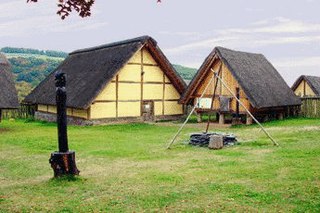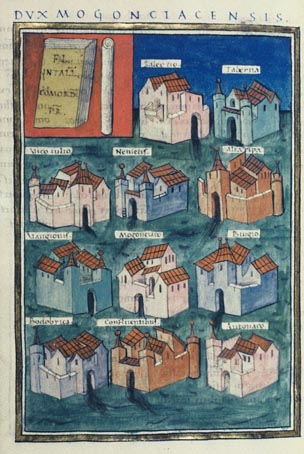
The Aresaces were Belgic tribe. They were closely related to, and probably originally part of, the Treveri. They inhabited the left bank of the Rhine in the Mainz -Bingen area, which was once the easternmost part of Treveran territory. [1]

The Aresaces were Belgic tribe. They were closely related to, and probably originally part of, the Treveri. They inhabited the left bank of the Rhine in the Mainz -Bingen area, which was once the easternmost part of Treveran territory. [1]
The Aresaces are not mentioned by ancient writers, such as geographers or Julius Caesar, but are known from three inscriptions dating to the 1st and 2nd centuries CE. [2] Two of these come from Rhenish Hesse, [1] while the third is from Augusta Treverorum (Trier), the capital of the Treveri.
A grave monument from Mainz-Weisenau that identifies the two deceased children as Treveri [3] has been explained as evidence that the Aresaces continued to regard themselves as a subdivision of the Treveri. [1] [4]
Another Celtic tribe in Rhenish Hesse, known from an inscription as well as ancient literature, was the Cairacates. [5]

According to current scholarship, the Aresaces would have been organized as a pagus or sub-unit of the Treveri, settled in Rhenish Hesse in the area south and east of Mainz. Their neighbours to the south were the Celtic Mediomatrici, while on the opposite bank of Rhine dwelled the Germanic Vangiones, Triboci, Nemetes, and the Mattiaci (a subdivision of the Chatti) in the area around present-day Wiesbaden.
This area was only sparsely settled during the late La Tène period, with larger settlements barely to be found in the second half of the 1st century BCE. One possible cultural and administrative centre of the Aresaces might have been the oppidum on the Donnersberg, which would have marked the southeasternmost centre of Treveran influence. Urbanization was only to increase noticeably at the time of, or shortly before, the Roman presence in the region.
At the time of the Romans' arrival in greater Mainz in 13–12 BCE, there were two or more lesser civilian settlements there that can probably be attributed to the Aresaces. One such at Mainz-Weisenau emerged either shortly before or at the same time as the Roman army camp at Mainz, while a village-like settlement at Mainz-Bretzenheim also straddled the banks of the Zaybach. There is further evidence for settlement at Mainz-Finthen near the Königborn and Aubach. [6]
A Celtic and later Roman temple district between Klein-Winternheim and Ober-Olm near Mainz was dedicated to Mars Loucetius and Nemetona; this is regarded as the tribal sanctuary of the Aresaces living in the area. [7] [8]

Under Domitian, if not before, the Romans administratively separated the area of Treveran territory on the left bank of the Rhine from the civitas Treverorum and the province of Gallia Belgica, attaching the Rhenish Hesse region to the newly organized province of Germania Superior. The Aresaces were likely to have been organized as a separate civitas from the Treveri at this stage, if not earlier, as were their neighbours the Cairacates. [9] Meanwhile, the city of Mainz—known in Latin as Mogontiacum—flourished as a legionary headquarters for a number of Roman legions [10] and also the capital of the province of Germania Superior.
The territory of the Aresaces was formerly thought to have belonged to the Vangiones, who would thus have occupied quite a large tract on the left bank of the Rhine. However, this interpretation is now considered superseded in light of archaeological discoveries. The Vangiones' settlement on the left bank of the Rhine, in the area of present-day Worms (ancient Civitas Vangionum or Borbetomagus), is now considered to have taken place only under the aegis of the Roman administration during the Augustan period. [11]

Mainz, previously known in English as Mentz or Mayence, is the capital and largest city of Rhineland-Palatinate, Germany.

Rhineland-Palatinate is a western state of Germany. It covers 19,846 km2 (7,663 sq mi) and has about 4.05 million residents. It is the ninth largest and sixth most populous of the sixteen states. Mainz is the capital and largest city. Other cities are Ludwigshafen am Rhein, Koblenz, Trier, Kaiserslautern, Worms and Neuwied. It is bordered by North Rhine-Westphalia, Saarland, Baden-Württemberg and Hesse and by France, Luxembourg and Belgium.

The Rhineland is a loosely defined area of Western Germany along the Rhine, chiefly its middle section.

In Gallo-Roman religion, Loucetios was a Gallic god known from the Rhine-Moselle region, where he was identified with the Roman Mars. Scholars have interpreted his name to mean ‘lightning’. Mars Loucetius was worshipped alongside the goddess Nemetona.

Nemetona, or 'she of the sacred grove', is a Celtic goddess with roots in northeastern Gaul. She is thought to have been the eponymous deity of the Germano-Celtic people known as the Nemetes; evidence of her veneration is found in their former territory along the Middle Rhine as well in the Altbachtal sanctuary in present-day Trier, Germany. She is also attested in Bath, England, where an altar to her was dedicated by a man of the Gallic Treveri people.

Legio XXII Primigenia was a legion of the Imperial Roman army dedicated to the goddess Fortuna Primigenia. Founded in AD 39 by the emperor Caligula for use in his campaigns in Germania, the XXII Primigenia spent much of their time in Mogontiacum up to the end of the 3rd century. The legion's symbols were a Capricorn and the demigod Hercules.

Germania Superior was an imperial province of the Roman Empire. It comprised an area of today's western Switzerland, the French Jura and Alsace regions, and southwestern Germany. Important cities were Besançon (Vesontio), Strasbourg (Argentoratum), Wiesbaden, and Germania Superior's capital, Mainz (Mogontiacum). It comprised the Middle Rhine, bordering on the Limes Germanicus, and on the Alpine province of Raetia to the south-east. Although it had been occupied militarily since the reign of Augustus, Germania Superior was not made into an official province until c. 85 AD.

Gallia Belgica was a province of the Roman Empire located in the north-eastern part of Roman Gaul, in what is today primarily northern France, Belgium, and Luxembourg, along with parts of the Netherlands and Germany.

The Trēverī were a Celtic tribe of the Belgae group who inhabited the lower valley of the Moselle in modern day Germany from around 150 BCE, if not earlier, until their displacement by the Franks. Their domain lay within the southern fringes of the Silva Arduenna, a part of the vast Silva Carbonaria, in what are now Luxembourg, southeastern Belgium and western Germany; its centre was the city of Trier, to which the Treveri give their name. Celtic in language, according to Tacitus they claimed Germanic descent. They possibly contained both Gallic and Germanic influences.

The Vangiones appear first in history as an ancient Germanic tribe of unknown provenance. They threw in their lot with Ariovistus in his bid of 58 BC to invade Gaul through the Doubs river valley and lost to Julius Caesar in a battle probably near Belfort. After some Celts evacuated the region in fear of the Suebi, the Vangiones, who had made a Roman peace, were allowed to settle among the Mediomatrici in northern Alsace.. They gradually assumed control of the Celtic city of Burbetomagus, later Worms.

The Mattiaci were by Tacitus recorded as an ancient Germanic tribe and related to the Chatti, their Germanic neighbors to the east. There is no clear definition of what the tribe's name meant. The Dictionary of Greek and Roman Geography suggests that the name is derived from a combination of 'matte', meaning 'a meadow', and 'ach', signifying water or a bath.

In classical antiquity, the Triboci or Tribocci were a Germanic people of eastern Gaul, inhabiting much of what is now Alsace.
The Germani cisrhenani, or "Left bank Germani", were a group of Germanic peoples who lived west of the Lower Rhine at the time of the Gallic Wars in the mid-1st century BC.

Nida was an ancient Roman town in the area today occupied by the northwestern suburbs of Frankfurt am Main, Germany, specifically Frankfurt-Heddernheim, on the edge of the Wetterau region. At the time of the Roman empire, it was the capital of the Civitas Taunensium. The name of the settlement is known thanks to written sources from Roman times and probably derives from the name of the adjacent river Nidda.

The Wetterau Limes is the name given in the field of historical research to that part of the Upper Germanic-Rhaetian Limes which enclosed the region that became known later as the Wetterau in the German state of Hesse.

The Castra Alteium is a former late-Roman border fort on the Danube-Iller-Rhine Limes (DIRL). It is located in the territory of the city of Alzey in Rhenish Hesse, Germany. The fort was presumably built in the course of the last reconstruction measures on the Rhine frontier between 367 and 370 AD under the western Emperor Valentinian I. Previously, there was a Roman civilian settlement (Vicus), Altiaia, which was devastated by Alamanni in 352–353. The fort was also destroyed twice, and probably abandoned at the end of the fifth century.
Contiomagus was a Gallo-Roman vicus in the Roman province of Gallia Belgica. The location today is the site of the district of Pachten in the municipality of Dillingen, Saarland.
The gens Secundinia was a minor plebeian family at ancient Rome. No members of this gens are mentioned by ancient writers, but a number are known from inscriptions, dating entirely or almost entirely from imperial times, and concentrated in Gaul, Germania, Noricum, and adjacent areas.
The gens Sollia was a minor plebeian family at ancient Rome. Few members of this gens appear in history, of whom the most famous is the fifth-century bishop and scholar Gaius Sollius Modestus Sidonius Apollinaris, a son-in-law of the emperor Avitus.
The gens Tertinia was an obscure plebeian family at ancient Rome. No members of this gens are mentioned in history, but a number are known from inscriptions, largely dating from the second and third centuries.